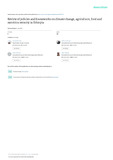| dc.contributor.author | Amwata, Dorothy A. | |
| dc.contributor.author | Eshetu, Z. | |
| dc.contributor.author | Mungai, C. | |
| dc.contributor.author | Solomon, D. | |
| dc.contributor.author | Radeny, M. | |
| dc.date.accessioned | 2021-07-12T09:26:52Z | |
| dc.date.available | 2021-07-12T09:26:52Z | |
| dc.date.issued | 2020-07 | |
| dc.identifier.citation | CCAFS Info Note. Addis Ababa, Ethiopia: CGIAR Research Program on Climate Change, Agriculture and Food Security (CCAFS). | en_US |
| dc.identifier.uri | https://ccafs.cgiar.org/resources/publications/review-policies-and-frameworks-climate-change-agriculture-food-and-3 | |
| dc.identifier.uri | https://www.researchgate.net/publication/343392575_Review_of_policies_and_frameworks_on_climate_change_agriculture_food_and_nutrition_security_in_Ethiopia | |
| dc.identifier.uri | http://hdl.handle.net/123456789/4715 | |
| dc.description.abstract | Agriculture is the mainstay of Ethiopia’s economy, contributing over 50% of the gross domestic product (GDP), accounting for more than 85% of the labor force and over 90% of the foreign exchange earnings (Alemu et al. 2010). Consequently, the sector receives considerable attention from the government, investing 15% of its total budget over the decade and meeting the commitments by Africa’s heads of states to the African Union Maputo 2003 Declaration on Agriculture and Food Security (CAADP 2003). On average, crop production makes up 60% of the sector’s outputs, livestock accounts for 27%, with other sub-sectors contributing 13% of the total value of agricultural production. The sector is dominated by small-scale farmers, practicing rain-fed mixed farming using traditional technologies, characterized with low levels of input use and low productivity. | en_US |
| dc.language.iso | en | en_US |
| dc.title | Review of policies and frameworks on climate change, agriculture, food and nutrition security in Ethiopia | en_US |
| dc.type | Technical Report | en_US |

